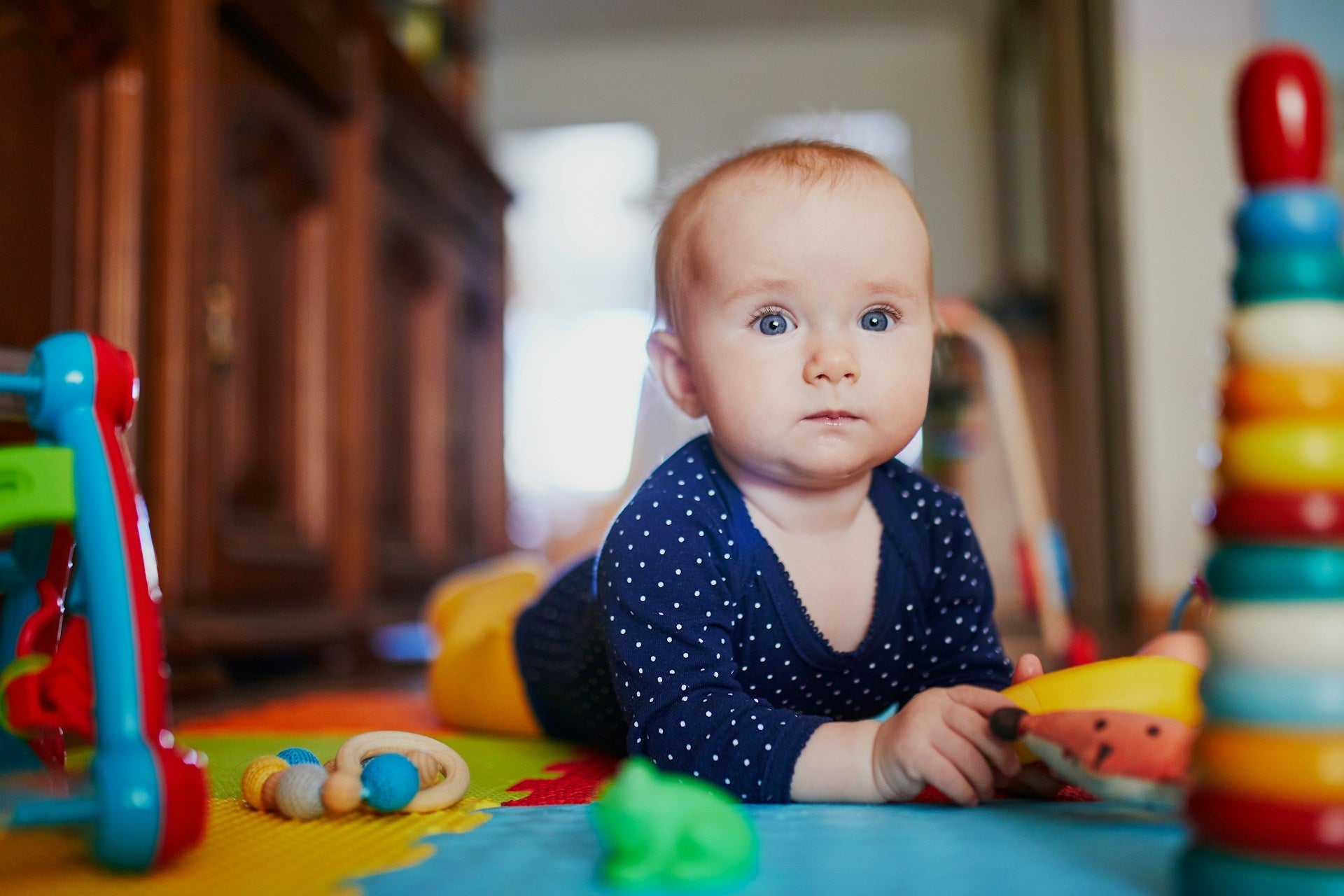A Guide to Montessori Visual Mobiles: Supporting Infant Growth from Birth

Careful attention is paid to each furnishing and material brought into the Montessori environment. This is no different in an infant environment. Beauty, functionality, and purpose are all considered when choosing materials to expose the child to. Because the infant is absorbing all of its surroundings, it is essential to curate an environment conducive to its development that aids its concentration and creates an inviting atmosphere for it to learn about the world.
The Montessori Visual Mobiles are critical materials used in the Montessori infant environment for the first three months (or more) of life. They support much of the baby's development during this time, including their visual development, gross and fine motor development, and concentration. Each mobile in the series serves a different purpose, and the skills are built upon one another.
The least developed sense in a newborn baby is sight. When they are first born, their vision is blurry, allowing them to see only objects or people that are relatively close to their face (about 12-18 inches). Initially, they also only see things in black, white, and shades of gray, but their vision develops and improves over the next few months. Each Montessori mobile assists in this development process by targeting various visual skills.
The Montessori mobiles are essential because infants must practice coordinating their eyes for vision to develop. The Montessori mobiles stimulate visual tracking by encouraging the baby to follow a moving object, an essential pre-reading skill. The mobiles also encourage both eyes to work together by focusing on the individual objects in the mobile, which becomes necessary when they reach for things. Some of the mobiles also encourage color discrimination and depth perception. All of the mobiles support your baby's developing concentration. They are all lightweight, allowing them to move with natural airflow rather than mechanical. This subtly teaches the baby about cause and effect.
Four Montessori Visual mobiles are introduced sequentially: the Munari, the Octahedron, the Gobbi, and the Dancers. While there are recommended ages for each mobile, every child develops differently and has different needs. It is essential to observe your baby to determine when they are ready to be introduced to each mobile. The mobiles are designed to offer just enough challenge without overwhelming an infant; the simple designs and colors are not overstimulating as some other mobiles can be.
The first Montessori mobile is the Munari. The Munari is a black and white mobile with three dowels, a glass ball, and various two-dimensional geometric shapes. The purpose of the glass ball is to reflect light, and the dowels and shapes are all various compositions of black and white to provide high-contrast stimulation. The black and white images stimulate the development of the optic nerves and encourage infants' cognitive development without overstimulating them. This mobile is introduced first because of the undeveloped eyesight in newborns. A mobile with less contrast would not be as quickly seen by the infant and would not likely engage them like the high-contrast colors in the Munari. This mobile can be introduced from birth or when the infant is comfortable being laid down independently. The Munari is typically enjoyed by infants until around four to six weeks.
The second mobile is the Octahedron. The Octahedron consists of three octahedrons in the primary colors (red, yellow, and blue hanging from a dowel. They are usually made with reflective paper folded into an octahedron shape. This mobile is typically introduced around four to six weeks, and babies are often ready for the following mobile when they are around eight to ten weeks old. The three-dimensional objects are a new feature from the previous mobile, composed chiefly of two-dimensional shapes. The primary colors are introduced when your baby's vision has developed more, and they can see colors more clearly. The primary colors are bold and vary enough in contrast so that the infant can focus on each Octahedron individually or the mobile as a whole. This engages them to use both eyes to look at one object, a skill they are still developing.
The third mobile in the series is the Gobbi. The Gobbi mobile features five shades of a single color, displayed via spheres of the same size hanging from a dowel. The darkest shades are the lowest, closest to the baby's face, and the lightest is the highest, with the others hung in ascending order, creating a diagonal line. Typically, the spheres are made of styrofoam balls wrapped in embroidery thread or yarn. This mobile is introduced around eight to ten weeks when babies can see the entire color spectrum. The slight variations in color between the spheres help to develop the child's visual discrimination. It also works to refine their chromatic sense, which they will continue to explore in the Montessori environment. The spheres are hung at different levels to help with depth perception.
The final mobile of the Montessori Visual Mobiles is the Dancers. The Dancers, composed of metallic or shiny paper, are made to look like simple or abstract human figures. The heads, arms, and legs are all attached separately so they can move individually to make it look like they are dancing, giving it the name The Dancers. Like the Octahedron, the Dancers use iridescent paper to catch and reflect correctly, further engaging the child. Each piece is attached separately to strengthen the baby's visual tracking and depth perception as they watch the mobile move organically. This mobile can be introduced around ten to twelve weeks or when your baby seems no longer challenged by the Gobbi.
The best time to use the Montessori mobiles is when your baby is alert, well-rested, and fed. Mobiles should be hung in the movement area, about 12 inches above the infant, to allow for optimal visual stimulation without it being in reach of an accidental grasp or kick. The mobile can be hung from a long ceiling chain or a portable mobile stand. Because this is the child's work, they should be able to turn away from it if they get overstimulated, and it should not be placed above their sleep space. They should have a separate area for sleep and work/play to support their sense of order. Babies may be able to focus for up to 15 or 20 minutes at this age. However, shorter spurts are more likely because they still require a lot of contact with their caregiver during the symbiotic period. While you should not interrupt their concentration, it is best to stay with them when they are using their mobile so that you can observe them and determine when/if they are ready for the following mobile. Consider changing out the mobiles slowly when lying under them so they can see where their previous work is going. They do not yet have object permanence, so you can let them be part of the process to provide a more gentle transition to a new mobile.
While many of the skills encouraged by the mobiles could be developed by other means, they are a beautiful addition to a Montessori infant space and are backed by research to support your baby's development.
The Montessori Visual Mobiles are critical materials used in the Montessori infant environment for the first three months (or more) of life. They support much of the baby's development during this time, including their visual development, gross and fine motor development, and concentration. Each mobile in the series serves a different purpose, and the skills are built upon one another.
The least developed sense in a newborn baby is sight. When they are first born, their vision is blurry, allowing them to see only objects or people that are relatively close to their face (about 12-18 inches). Initially, they also only see things in black, white, and shades of gray, but their vision develops and improves over the next few months. Each Montessori mobile assists in this development process by targeting various visual skills.
The Montessori mobiles are essential because infants must practice coordinating their eyes for vision to develop. The Montessori mobiles stimulate visual tracking by encouraging the baby to follow a moving object, an essential pre-reading skill. The mobiles also encourage both eyes to work together by focusing on the individual objects in the mobile, which becomes necessary when they reach for things. Some of the mobiles also encourage color discrimination and depth perception. All of the mobiles support your baby's developing concentration. They are all lightweight, allowing them to move with natural airflow rather than mechanical. This subtly teaches the baby about cause and effect.
Four Montessori Visual mobiles are introduced sequentially: the Munari, the Octahedron, the Gobbi, and the Dancers. While there are recommended ages for each mobile, every child develops differently and has different needs. It is essential to observe your baby to determine when they are ready to be introduced to each mobile. The mobiles are designed to offer just enough challenge without overwhelming an infant; the simple designs and colors are not overstimulating as some other mobiles can be.
The first Montessori mobile is the Munari. The Munari is a black and white mobile with three dowels, a glass ball, and various two-dimensional geometric shapes. The purpose of the glass ball is to reflect light, and the dowels and shapes are all various compositions of black and white to provide high-contrast stimulation. The black and white images stimulate the development of the optic nerves and encourage infants' cognitive development without overstimulating them. This mobile is introduced first because of the undeveloped eyesight in newborns. A mobile with less contrast would not be as quickly seen by the infant and would not likely engage them like the high-contrast colors in the Munari. This mobile can be introduced from birth or when the infant is comfortable being laid down independently. The Munari is typically enjoyed by infants until around four to six weeks.
The second mobile is the Octahedron. The Octahedron consists of three octahedrons in the primary colors (red, yellow, and blue hanging from a dowel. They are usually made with reflective paper folded into an octahedron shape. This mobile is typically introduced around four to six weeks, and babies are often ready for the following mobile when they are around eight to ten weeks old. The three-dimensional objects are a new feature from the previous mobile, composed chiefly of two-dimensional shapes. The primary colors are introduced when your baby's vision has developed more, and they can see colors more clearly. The primary colors are bold and vary enough in contrast so that the infant can focus on each Octahedron individually or the mobile as a whole. This engages them to use both eyes to look at one object, a skill they are still developing.
The third mobile in the series is the Gobbi. The Gobbi mobile features five shades of a single color, displayed via spheres of the same size hanging from a dowel. The darkest shades are the lowest, closest to the baby's face, and the lightest is the highest, with the others hung in ascending order, creating a diagonal line. Typically, the spheres are made of styrofoam balls wrapped in embroidery thread or yarn. This mobile is introduced around eight to ten weeks when babies can see the entire color spectrum. The slight variations in color between the spheres help to develop the child's visual discrimination. It also works to refine their chromatic sense, which they will continue to explore in the Montessori environment. The spheres are hung at different levels to help with depth perception.
The final mobile of the Montessori Visual Mobiles is the Dancers. The Dancers, composed of metallic or shiny paper, are made to look like simple or abstract human figures. The heads, arms, and legs are all attached separately so they can move individually to make it look like they are dancing, giving it the name The Dancers. Like the Octahedron, the Dancers use iridescent paper to catch and reflect correctly, further engaging the child. Each piece is attached separately to strengthen the baby's visual tracking and depth perception as they watch the mobile move organically. This mobile can be introduced around ten to twelve weeks or when your baby seems no longer challenged by the Gobbi.
The best time to use the Montessori mobiles is when your baby is alert, well-rested, and fed. Mobiles should be hung in the movement area, about 12 inches above the infant, to allow for optimal visual stimulation without it being in reach of an accidental grasp or kick. The mobile can be hung from a long ceiling chain or a portable mobile stand. Because this is the child's work, they should be able to turn away from it if they get overstimulated, and it should not be placed above their sleep space. They should have a separate area for sleep and work/play to support their sense of order. Babies may be able to focus for up to 15 or 20 minutes at this age. However, shorter spurts are more likely because they still require a lot of contact with their caregiver during the symbiotic period. While you should not interrupt their concentration, it is best to stay with them when they are using their mobile so that you can observe them and determine when/if they are ready for the following mobile. Consider changing out the mobiles slowly when lying under them so they can see where their previous work is going. They do not yet have object permanence, so you can let them be part of the process to provide a more gentle transition to a new mobile.
While many of the skills encouraged by the mobiles could be developed by other means, they are a beautiful addition to a Montessori infant space and are backed by research to support your baby's development.








